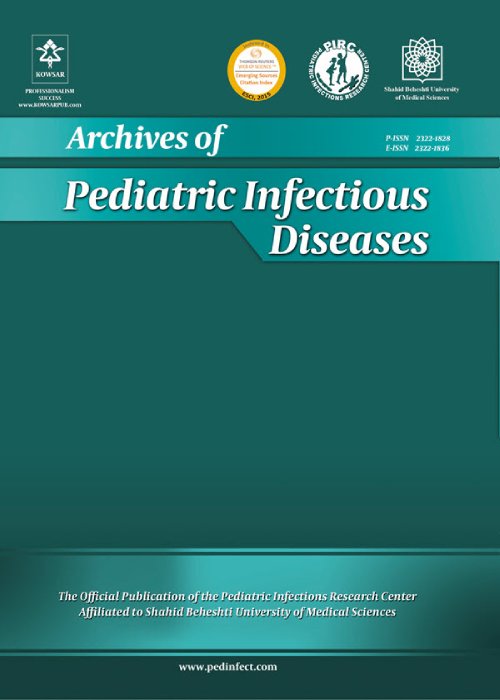Evaluation of the Virulence Features and Antibiotic Resistance Patterns of Pathogenic Pseudomonas aeruginosa Strains Isolated from Hospitalized Patients in Gonabad, Iran
Author(s):
Abstract:
Background
Pseudomonas aeruginosa is a ubiquitous microorganism, which is present in diverse environmental niches and is seldom a member of normal human microbiota community. P. aeruginosa is an increasingly problematic drug-resistant bacterium in todays world. In fact, we are now faced with growing clones of pandrug-resistant P. aeruginosa in hospital settings.Objectives
The aim of the present study was to examine the antibiotic resistance patterns and presence of nan1 and int1 virulence genes (encoding neuraminidase and class 1 integrons, respectively) in clinical P. aeruginosa isolates and to analyze the measured values with regard to hospital wards, specimens, and antibiotic resistance of the strains.Methods
In this cross sectional study, strains recovered consecutively from different samples of hospitalized patients between 2014 and 2016 in Gonabad, Iran, were tested. Culture of specimens was performed on common bacteriological culture media. The isolates were recognized as P. aeroginosa, based on morphological and biochemical tests. The isolates, identified as presumptive P. aeruginosa, were further confirmed by species-specific polymerase chain reaction (PCR) to detect exoA gene. All the isolates were tested for their antimicrobial susceptibility patterns, using the standard guidelines issued by the clinical and laboratory standards institute (CLSI). Genes encoding the virulence factors (nan1 and int1) were investigated by PCR using specific primers.Results
Overall, 95 P. aeruginosa isolates were studied during the study period. The isolates were recovered from 30 (31.6%) males and 65 (68.4%) females. In total, 34 (35.5%) infected patients were in the age group of 30 - 44 years. There were 24 (25.3%) patients hospitalized in the intensive care unit (ICU). A total of 31 (32.6%) strains were isolated from the blood. Colistin was the most effective antibiotic against the isolates, and ticarcillin was the least effective antimicrobial agent. Based on the findings, 21.1% of the P. aeroginosa strains were resistant to the quinolone class of antimicrobial agents. Also, ceftazidime resistance was detected in the isolates (10.5%). Based on the results, 5.26% of the tested isolates were co-resistant to ceftazidime, amikacin, and piperacillin/tazobactam. Among 95 P. aeroginosa isolates on which PCR assay was performed, 44.2% had the nan1 gene.Conclusions
Selection of the most effective anti-Pseudomonal drug (including in vitro test and report) is a decision best made by each clinical microbiology laboratory in consultation with the infectious diseases practitioners and pharmacologists, as well as therapeutic and hospital infection control committees. The guidelines for each bacterium include antibiotics of confirmed effectiveness, which show acceptable results in antibiotic susceptibility tests.Keywords:
Language:
English
Published:
Archives of Pediatric Infectious Diseases, Volume:5 Issue: 3, Jul 2017
Page:
5
magiran.com/p1719442
دانلود و مطالعه متن این مقاله با یکی از روشهای زیر امکان پذیر است:
اشتراک شخصی
با عضویت و پرداخت آنلاین حق اشتراک یکساله به مبلغ 1,390,000ريال میتوانید 70 عنوان مطلب دانلود کنید!
اشتراک سازمانی
به کتابخانه دانشگاه یا محل کار خود پیشنهاد کنید تا اشتراک سازمانی این پایگاه را برای دسترسی نامحدود همه کاربران به متن مطالب تهیه نمایند!
توجه!
- حق عضویت دریافتی صرف حمایت از نشریات عضو و نگهداری، تکمیل و توسعه مگیران میشود.
- پرداخت حق اشتراک و دانلود مقالات اجازه بازنشر آن در سایر رسانههای چاپی و دیجیتال را به کاربر نمیدهد.
دسترسی سراسری کاربران دانشگاه پیام نور!
اعضای هیئت علمی و دانشجویان دانشگاه پیام نور در سراسر کشور، در صورت ثبت نام با ایمیل دانشگاهی، تا پایان فروردین ماه 1403 به مقالات سایت دسترسی خواهند داشت!
In order to view content subscription is required
Personal subscription
Subscribe magiran.com for 70 € euros via PayPal and download 70 articles during a year.
Organization subscription
Please contact us to subscribe your university or library for unlimited access!


